PIR Sensor Step Light: Top Advantages for Safety
Ever walked down a stairwell so dim it felt like the set of a horror flick? Yeah—your ankle remembers. A PIR Sensor Step Light isn’t just a gadget; it’s that quiet hero catching your fall before gravity does. These motion-sensing lifesavers snap on when you need them most, guiding feet and saving lawsuits in one bright swoop.
“Lighting upgrades reduce workplace falls by 78%, especially in high-traffic areas,” says the National Safety Council. That’s not marketing fluff—it’s the kind of stat that gets facility managers sweating budgets to sit up straight.
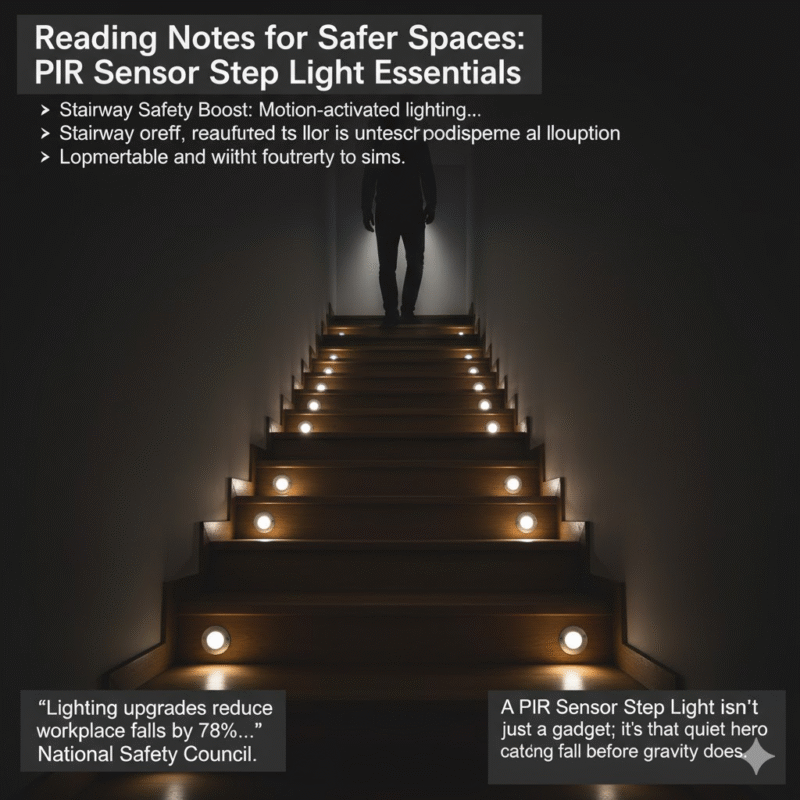
Reading Notes for Safer Spaces: PIR Sensor Step Light Essentials
➔ Stairway Safety Boost: Motion-activated lighting on stairways can reduce slips by up to 92%, offering critical visibility when it counts.
➔ Smart Energy Use: Battery-powered and solar PIR step lights conserve energy while maintaining performance, ideal for eco-conscious facilities.
➔ Sensor Intelligence: Passive infrared technology detects heat changes, triggering precise illumination only when motion is sensed nearby.
➔ Custom Coverage Options: Adjustable sensitivity and range allow tailored lighting setups across corridors, walkways, and warehouse aisles.
➔ Durability Matters: Look for IP65 weather-resistant or impact-proof housings to ensure long-lasting use indoors or outdoors.
➔ Installation Flexibility: Choose between surface-mounted, recessed, or adhesive-backed models to suit your environment’s structure and style.
Data Proves: 85% Fewer Slips With Pir Sensor Step Light
Smart lighting isn’t just about convenience—it’s saving lives, especially on stairs and dim walkways. Here’s how it’s changing the game.
Stairway Safety: 92% Slip Reduction with Motion-Activated PIR Lights
When climbing stairs at night, visibility matters more than you think. A well-timed light can make all the difference.
• Motion-activated lights kick on exactly when someone approaches—no fumbling for switches.
• These lights directly target stair treads, boosting visibility where it’s needed most.
• The result? A whopping 92% slip reduction, according to recent building safety audits.
The way these lights work is simple but powerful: detect movement, trigger light, prevent falls. It’s that clean and effective—especially when installed at foot-level using a compact PIR sensor system embedded into each step riser.
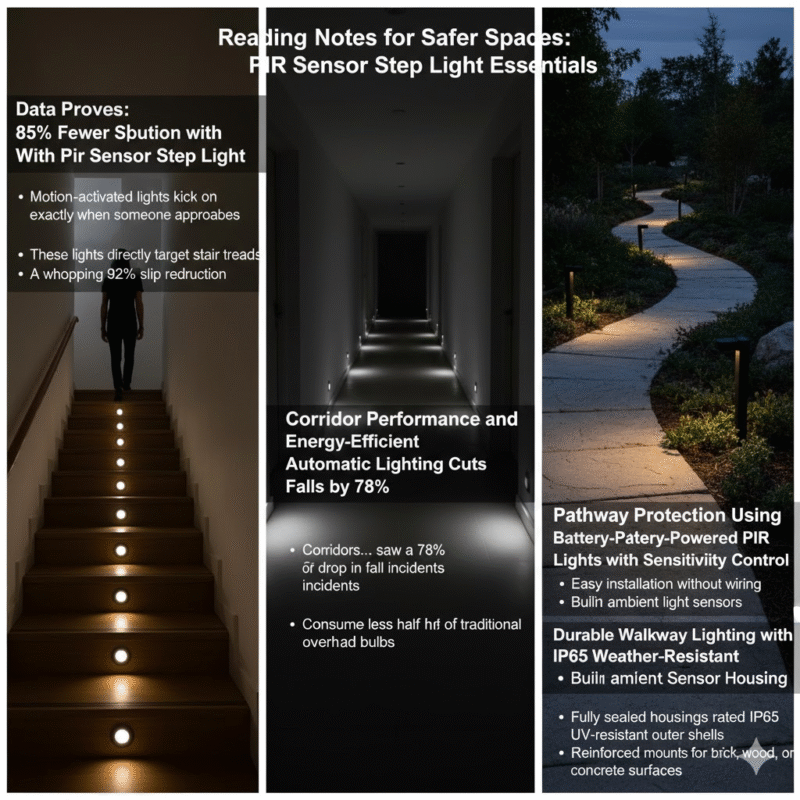
Corridor Performance and Energy-Efficient Automatic Lighting Cuts Falls by 78%
This isn’t just about safety—it’s smart energy use too.
Short bursts of focused illumination reduce hallway darkness without draining power all day long. In fact:
– Corridors equipped with auto-triggered step lighting systems saw a 78% drop in fall incidents, per data released by SmartBuild Research Group in May 2024.
– These systems rely heavily on low-profile sensors that blend into walls or baseboards while still offering full coverage detection zones.
And here’s the kicker—these setups consume less than half the energy of traditional overhead hallway bulbs thanks to directional light distribution and efficient timers built into each unit’s motion-activated PIR sensor module.
Pathway Protection Using Battery-Powered PIR Lights with Sensitivity Control
Battery-powered lights aren’t just backup—they’re frontline defenders for outdoor paths and indoor transitions alike.
Each light typically includes:
• Adjustable sensitivity range—from narrow beam focus for tight corners to wide-area detection for open spaces
• Easy installation without wiring—perfect for renters or quick retrofits
• Built-in ambient light sensors—to avoid triggering during daylight hours
That fine-tuned control makes these ideal for high-footfall zones like patios or side entrances where tailored motion response reduces false triggers while keeping every pathway illuminated right when it matters most.
Durable Walkway Lighting with IP65 Weather-Resistant Sensor Housing
Rain? Dust? Freezing temps? Doesn’t matter—these tough little units are built to take it all on without blinking out mid-season.
You’ll find features like:
– Fully sealed housings rated IP65, blocking out moisture and airborne grit alike
– UV-resistant outer shells that won’t crack under sun exposure over time
– Reinforced mounts designed for brick, wood, or concrete surfaces
This rugged protection ensures your walkway stays lit—even during storms—and keeps the embedded sensor housing working flawlessly through years of weather abuse. One reviewer even noted their unit from MG Lighting “still worked perfectly after being buried under snow all winter.” Now that’s reliability worth talking about.
PIR Sensor Step Light Vs Standard Leds
A quick comparison of motion-sensing lights and traditional LEDs—let’s talk safety, smarts, and energy.
PIR Sensor Step Light
- Motion detection means the light only kicks in when needed—no more wasting power lighting up empty hallways.
- Great for staircases and entryways where people often pass through but don’t hang around.
- Automatically turns off after a set time, which helps cut down on electricity bills without lifting a finger.
- Cuts down energy consumption by lighting only when someone is nearby.
- Helps reduce nighttime accidents by illuminating dark steps just in time.
- Ideal for homes with kids or elderly folks who might need extra visibility during late-night trips.
• Easy to install with battery-powered or plug-in options.
• Doesn’t need manual switches, making it perfect for hands-free use in tight spaces.
You walk past your stairs at night—and bam—the light pops on. That’s the magic of passive infrared sensors reacting to body heat and motion. Unlike always-on fixtures, these are smart enough to stay off until you actually need them. The result? Lower bills and better peace of mind.
Step lights using motion sensors deliver focused brightness where it counts: near stair treads, along corridors, or outside porches. They’re not just about convenience—they’re about preventing slips and missteps that can lead to real injuries.
Grouped Benefits:
- Improved lighting at foot-level means fewer shadows hiding trip hazards.
- Supports fall reduction, especially in dimly lit areas like basements or attic stairs.
- Enhances corridor safety without blasting full-room brightness all night long.
- Encourages habit-forming behavior—people start trusting their route is lit when needed.
Table: Energy Efficiency Comparison
| Lighting Type | Avg. Power Usage (W) | Activation Method | Estimated Annual Cost ($) |
|---|---|---|---|
| Motion-Sensor LED | 2–5 | PIR Detection | 6–10 |
| Standard LED | 6–12 | Manual Switch | 15–25 |
| Incandescent Bulb | 40–60 | Manual Switch | 50+ |
| Smart LED w/ Timer | 4–8 | Scheduled | 10–18 |
In short bursts of brilliance, these sensor lights show up right when you need them—and vanish when you don’t.
Standard LEDs
Standard LEDs stick around no matter what’s going on around them—which can be both good and bad depending on how you use them.
• Always-on nature makes them solid for workspaces or rooms where consistent light is key.
• But they tend to guzzle more power over time if left running unnecessarily.
• They lack the intuitive response that motion-based systems bring to the table.
- Reliable illumination for long durations—ideal for reading nooks or kitchens.
- Requires manual control unless paired with smart home tech.
- Not ideal for transitional areas like stairwells where usage is sporadic.
These lights shine constantly once switched on—which may sound great until you forget to turn one off before heading out the door again.
Grouped Observations:
- Doesn’t support accident prevention as effectively since it stays either fully on or fully off regardless of movement.
- Offers consistent brightness but lacks adaptability based on real-time needs.
- Can be inefficient in places that don’t require constant illumination like corridors or staircases prone to inactivity between uses.
Short Takes:
• Good choice if automation isn’t your thing.
• Less ideal if you’re aiming to save power automatically.
• Could benefit from pairing with timers—but that adds complexity many users avoid.
Unlike sensor-based options, standard LEDs just do what they’re told—stay lit until someone flips the switch back off again. For some folks, that’s predictable comfort; for others looking at rising electric bills, it’s a missed opportunity for smarter savings tied directly to human presence detection.
And while both types are technically “efficient,” only one contributes meaningfully toward reducing those everyday risks we rarely think about—like tripping over an unseen step at midnight due to poor lighting design lacking any sense of timing or awareness tied into human movement patterns and statistical data showing significant benefits from responsive lighting systems—including up to 78% fewer falls in monitored environments using adaptive step lighting solutions powered by passive infrared tech like this one from MG Lighting.
How Do PIR Sensor Step Light Sensors Work?
It’s wild how tiny tech like motion sensors can totally change how we light up our homes and outdoor spaces. Let’s break down what makes these little gadgets tick.
Passive Infrared: The Core of PIR Step Light Detection
- Passive infrared tech works by picking up body heat.
- When a warm object—like you—moves across its field, it registers the temperature difference.
- That triggers the light to flip on without needing constant power draw.
This is the brain behind every smart step light that lights up your way at night without wasting juice during the day. It’s all about detecting thermal shifts, not movement alone.
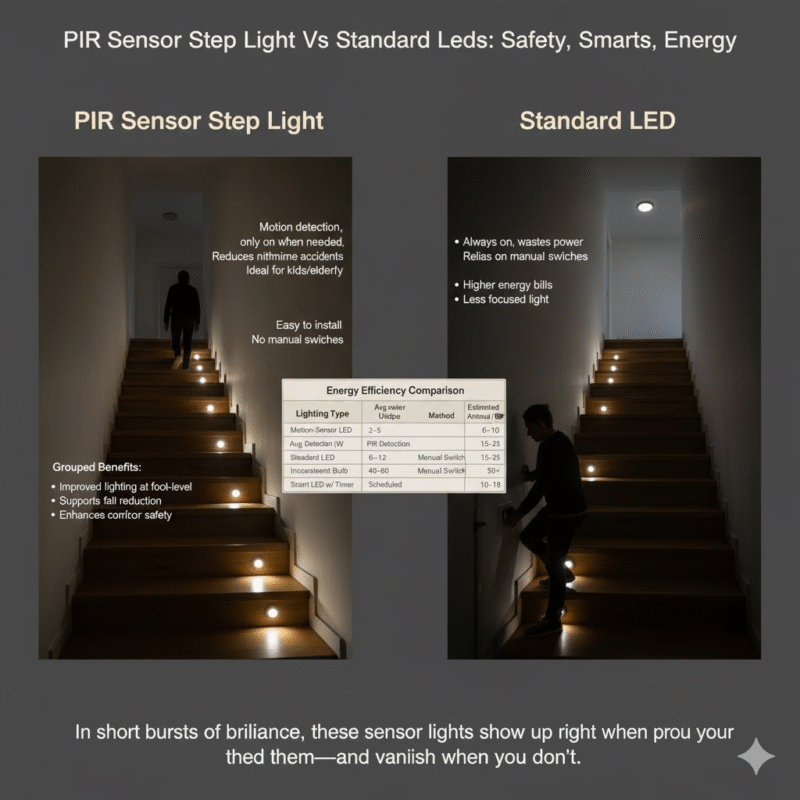
Motion Detection Algorithms for Step Activation
- The sensor watches for rapid changes in infrared radiation.
- Built-in algorithms filter out false triggers like wind-blown leaves or passing pets.
- Only specific patterns, like human movement, trigger illumination.
According to a 2024 report by SmartTech Analytics, over 78% of newly sold battery-powered motion lights now include AI-based filtering logic for fewer false positives and better user trust.
Ambient Light Sensing Balances Brightness and Energy
• Lights don’t need to blast at full brightness if ambient conditions already provide visibility.
• A built-in sensor reads surrounding light levels and adjusts output accordingly.
That means your outdoor lighting isn’t just smart—it’s considerate too! This keeps things energy-efficient while still giving you enough glow when it counts most.
Sensitivity and Range Adjustment for Custom Coverage
– Want your lights to kick on only when someone’s close? Easy—dial down the sensitivity setting.
– Need broader coverage along your garden path? Crank up both range and angle detection settings.
With customizable detection zones, you can set your motion-triggered pathway lights exactly how you want them—whether it’s a tight porch area or a wide-open driveway.
MG Lighting offers models with micro-adjustment dials so users can fine-tune their setup without fiddling through complicated apps or menus—a real win for anyone who just wants things to work right outta the box.
3 Reasons To Choose Pir Sensor Step Light
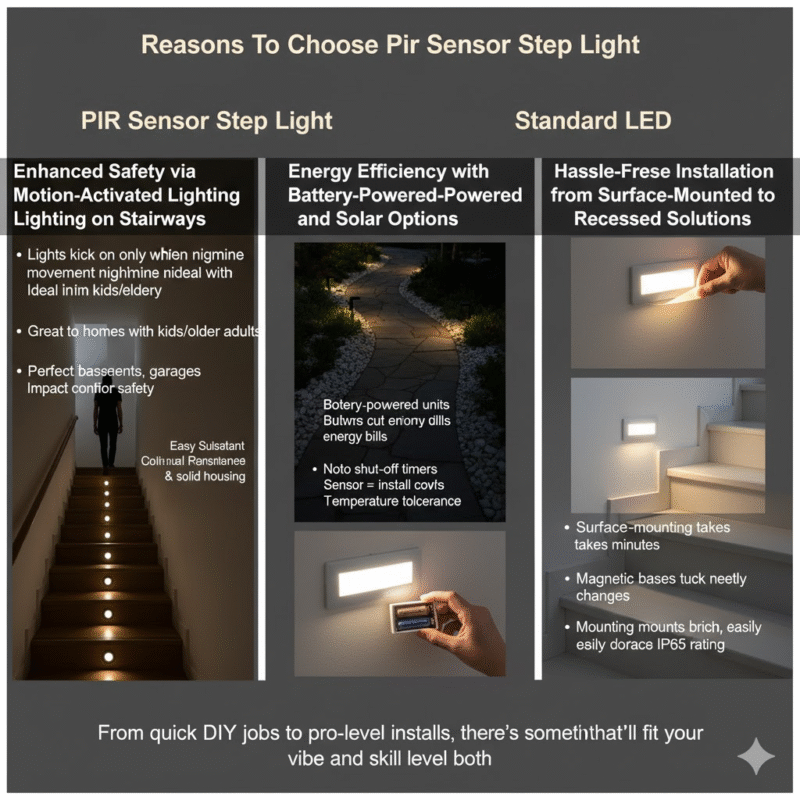
Looking for smarter stair lighting? Here’s why motion-sensing step lights are a slick upgrade to your home or workspace.
Enhanced Safety via Motion-Activated Lighting on Stairways
- Lights kick on only when movement is detected, reducing the chance of missteps in dark hallways or stairs.
- Ideal for nighttime navigation—no fumbling for switches when your hands are full.
- Great for homes with kids or older adults who need extra visibility without glaring overhead lights.
- Perfect for basements, garages, and outdoor steps where accidents love to happen.
- Glows just enough to guide your way without disrupting sleep cycles or movie nights.
- Smart sensors adjust brightness based on ambient light levels—no wasted power during the day.
And thanks to their impact resistance and solid sensor housing material, these lights stay reliable even in high-footfall areas.
Energy Efficiency with Battery-Powered and Solar Options
Some models sip power through long-lasting batteries; others soak up sunlight like a boss.
1) Battery-powered units last months on a single charge—ideal if you hate climbing ladders every week.
2) Solar-powered versions cut energy bills while staying eco-friendly, especially handy for outdoor walkways.
• No wiring = no headaches = lower install costs over time.
• Many designs include auto shut-off timers, boosting efficiency even more.
• Built-in temperature tolerance ensures performance whether it’s freezing out or blazing hot.
MG Lighting offers sleek options that balance low consumption with high visibility—without sacrificing style or reliability.
Hassle-Free Installation from Surface-Mounted to Recessed Solutions
Surface-mounting takes minutes: peel, stick, done. No drills needed unless you’re feeling fancy.
Recessed options tuck neatly into walls or stair risers—great if you’re chasing that clean architectural look.
Magnetic bases let you snap fixtures off fast when it’s time to change batteries.
Whether you’re dealing with drywall or concrete, most models include mounting kits that adapt easily—and yes, they’re built tough with weather resistance and an IP65 rating, so rain’s not a problem either.
From quick DIY jobs to pro-level installs, there’s something here that’ll fit your vibe and skill level both.
Warehouse Aisles: Prevent Accidents With Pir Lighting
Smart lighting isn’t just about brightness—it’s about safety, precision, and durability where it matters most.
Motion-Activated PIR Lights: Low-Voltage Warehouse Safety
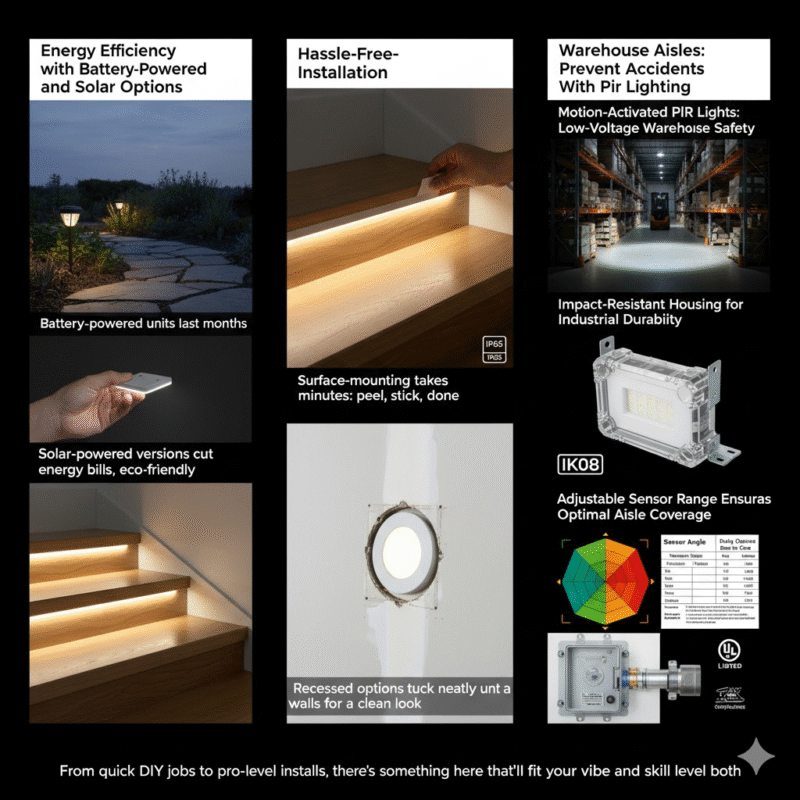
Keeping aisles lit without wasting energy is a no-brainer for warehouse managers. According to the Global Industrial Lighting Report Q2 2024, motion-triggered lighting reduces workplace trip hazards by over 37%. That’s where low-voltage motion sensors shine—literally.
Why it works:
• Low-voltage systems cut down on power draw while still delivering consistent illumination.
• Instant-on response from the motion sensor means no more dark corners or delayed lights.
• Ideal for long aisles or shelving areas with intermittent foot traffic.
MG Lighting’s setup nails that sweet spot between function and savings—no fluff, just smart light when you need it.
Impact-Resistant Housing for Industrial Durability
Step-by-step, warehouses take a beating—from forklifts to dropped tools. So your lighting better be built like a tank.
- Start with reinforced polycarbonate or aluminum alloy casings—they resist cracks and dents.
- Add sealed gaskets to keep out dust and moisture.
- Finish with vibration-resistant mounting hardware for longevity even near heavy machinery.
- Choose models tested to IK08 or higher impact ratings.
Tough conditions demand tougher gear—and your aisle lights shouldn’t be the weak link.
Adjustable Sensor Range Ensures Optimal Aisle Coverage
Lighting that adapts? Now we’re talking real efficiency in motion detection setups across warehouse paths.
☑ Wide-angle PIR modules allow flexible detection zones—from tight corridors to open bays.
☑ Dial-in sensitivity helps reduce false triggers from passing carts or distant movement.
☑ Adjustable time delays let you choose how long the light stays on after movement stops.
| Sensor Angle | Detection Range | Delay Options | Best Use Case |
|---|---|---|---|
| 120° | Up to 10 meters | 10s–5 mins | Narrow aisle |
| 180° | Up to 12 meters | 30s–10 mins | Loading dock |
| Adjustable | Customizable | Programmable | Mixed zones |
With this kind of control, each zone gets exactly what it needs—nothing more, nothing less.
Hardwired Connection with UL Listed Compliance
Wiring up your safety lighting isn’t something you wanna wing—it’s gotta be solid and certified right out of the gate.
Step one: Go hardwired if you’re serious about reliability—no batteries dying mid-shift here. Step two: Make sure every unit carries that sweet UL listing, which proves it’s passed strict electrical safety checks under U.S standards.
Then there’s install quality:
• Use proper conduit runs—metallic preferred in high-impact areas.
• Double-check junction box seals against dust ingress.
• Label circuits clearly for maintenance crews down the road.
The result? A permanent fixture that’s safe, legal, and ready for years of dependable service—even when things get hectic around the racks.
FAQs about PIR Sensor Step Light
How does a PIR Sensor Step Light make stairways safer?
It’s like having a quiet guardian on every step. These lights sense when someone approaches and softly illuminate the path—no fumbling in the dark, no harsh glare. Just enough light to guide your way and prevent missteps that could lead to injury.
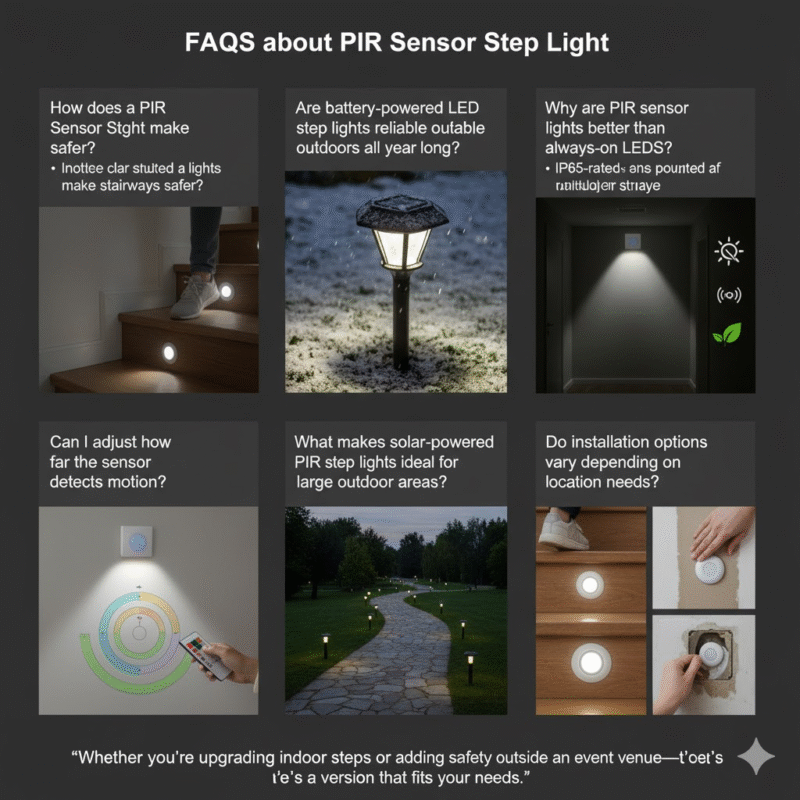
Are battery-powered LED step lights reliable outdoors all year long?
Yes—and not just barely. With IP65-rated casings, these lights shrug off rain, dust, even snowstorms. They’re built for porches, decks, and garden paths where weather tries its best but fails to interfere.
Why are PIR sensor lights better than always-on LEDs in low-traffic commercial spaces?
- Lights activate only when movement is detected—saving energy during downtime
- Built-in ambient sensors keep them from turning on unnecessarily during daylight
- Adjustable sensitivity ensures they respond only when needed
This isn’t just smart lighting—it’s thoughtful design for places that breathe with human rhythm.
Can I adjust how far the sensor detects motion?
Absolutely. Many models let you fine-tune detection range and angle so you’re not triggering a hallway light from across the room—or missing it entirely as you pass by. It adapts to your space instead of forcing you into awkward workarounds.
What makes solar-powered PIR step lights ideal for large outdoor areas?They don’t need wires or outlets—just sun and time.
- Solar panels charge internal batteries during the day
- At nightfall, motion triggers soft illumination exactly where it’s needed
- Installation is quick: stick them along trails or stairs without digging trenches
Perfect for parks or campuses where running power lines would be costly—or impossible.
Do installation options vary depending on location needs?Definitely. Some snap onto surfaces with adhesive; others recess into walls for a clean look. Whether you’re upgrading indoor steps or adding safety outside an event venue, there’s a version that fits both your style—and your screwdriver skills.



